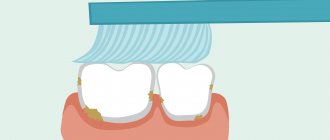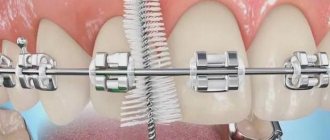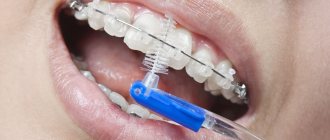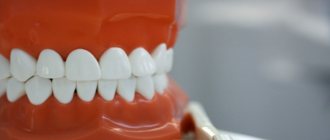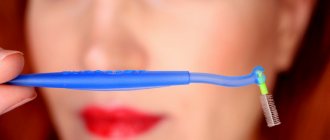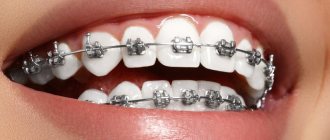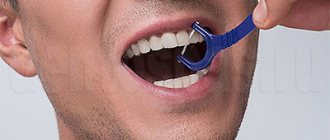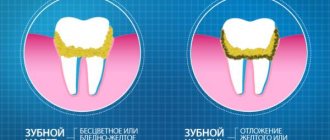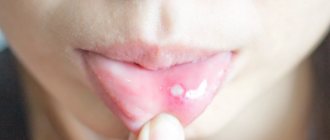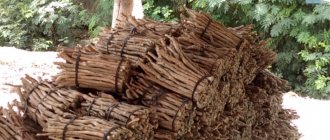How often do we think about whether we brush our teeth correctly? Of course not. Only after visiting a dentist can we analyze the results of our hygiene based on the condition of our oral cavity and draw up a treatment plan. And it turns out that there are not only rules for brushing teeth, but many scientific dentists have come up with various methods of brushing teeth. Methods for brushing teeth have been invented since 1922 (for example, the Charter method). There are many modern methods of brushing teeth. For example, the method of Bass, Leonardo, Fones, etc. I think it is reasonable if the patient manages to master the usual standard method of brushing his teeth and carefully monitor its implementation in practice.
Improper brushing of teeth
Let's admit it, we brush our teeth automatically. And we often do it wrong: we clean them with movements left and right, sherk-sherk. With this method of cleaning, soft plaque is transferred from the surface of the teeth to the interdental spaces and becomes clogged there. As a result, there is a danger of gum damage and the appearance of a wedge-shaped defect, especially on protruding teeth. A wedge-shaped defect is a lesion of a tooth in the area of contact with the gum. It looks like a step that resembles a wedge. The dimensions can range from barely noticeable to complete chipping in the future.
See what happens when we brush our teeth across their growth:
Features of brushing teeth with restoration structures
Compliance with the rules of oral hygiene is of great importance in cases where there are various types of restorations in the mouth - such as veneers, lumineers and crowns, as well as bridges and implants.
Plaque accumulates on artificial surfaces no less than on natural teeth, and sometimes even more. In addition, the patient’s future health depends on the quality of oral hygiene. For example, if in the case of implantation you neglect to brush your teeth, then you can get inflammation and rejection of the implant. As for bridges, the space between the bridge and the gum will require careful care. In the case of ceramic veneers and lumineers, hygiene is also equally important. At the border between them and the native enamel, food debris can accumulate and plaque can form, which can ultimately lead to caries. The danger lies in the fact that under the thinnest plates, which are veneers and lumineers, you may not notice how the carious process develops. Irrigators will also be useful for artificial restorations - special devices that, using water pressure, help clean even the most inaccessible places. In addition, the device heals the gums and generally improves the effectiveness of oral hygiene. Today, manufacturers offer a fairly wide range of models, so you can choose an irrigator to suit any needs and budget.
No matter how thoroughly and regularly we brush our teeth, it is still not enough. Once every six months or a year, it is necessary to visit a hygienist’s office, where, with the help of ultrasound and sandblasting machines such as Air Flow, the teeth undergo general treatment, and their owner gains a confident and beautiful smile!
Standard method of brushing teeth Pakhomova G.N.
This method is recommended by most Russian dentists. It was invented by G.N. Pakhomov - professor of dentistry.
- Cleaning begins from the upper jaw in the following order - from the right molars to the front ones, then finishes on the left molars.
- On the lower jaw, the left major ones are cleaned first, then the anterior ones, and lastly the right molars.
- The front and back surfaces are cleaned with sweeping movements from bottom to top, with the brush head at an angle of 45° to the gum.
- It is important to make 10 movements for each tooth.
- Contaminants from the chewing side are removed by moving the head back and forth.
- To clean the front teeth, the brush is placed vertically and moved in a sweeping motion.
The Pakhomov method helps to effectively clean the oral cavity, but for the interdental spaces additional means are needed - irrigators, threads and a tongue scraper.
How to brush your teeth correctly?
There are other methods of brushing teeth: the Leonard method, the Reite method, the Bass method, the Smith-Bell method, the Stillman method, the Fones method, the Charter method. Each of these methods is selected taking into account the condition of the teeth and periodontium. For example, for gingivitis during puberty, it is recommended to use gentle teeth brushing techniques, which include the Charter and Bass method.
How to brush your teeth - The Charter Method
The method is used to clean teeth and gums, and to massage the gums. In this case, the toothbrush is positioned so that the bristles are at an angle of 45 degrees to the gingival margin. Without removing the bristles, perform gentle shaking or circular movements, while the bristles penetrate between the teeth.
How to brush your teeth - Bass Method
The brush is placed at an angle of 45 degrees to the tooth axis, their ends partially penetrate the gingival groove and interdental spaces. The brush moves vibrating forward and backward.
These two methods help clean the gingival grooves, interdental spaces and contact surfaces of the teeth.
How to brush your teeth - The Leonard Method
It is performed using a brush, which is placed perpendicular to the surface of the teeth, making only perpendicular movements in the direction from the gums to the crown.
How to brush your teeth - Reite Method
With the Reite method, the bristles are placed parallel to the axis of the tooth, performing rolling movements from the gums to the crown.
How to brush your teeth - Smith-Bell Method
With this method of brushing teeth, the movements of the brush follow the path of food during chewing. The brush is placed perpendicular to the chewing surface and in this position, with gentle pressure and rotation, is advanced to the gum.
How to brush your teeth - The Stillman Method
The method is performed by pressing on the gingival margin with a brush using weak rotational movements. The bristles are installed so that their ends partially lie at an angle to the axis of the tooth, and partially on the gum.
Assistive methods for brushing with a toothbrush
Fones method
It belongs to the American dentist Alfred Fones, who is considered one of the founders of hygienic dentistry. The method is suitable for adults, children and people who do not have periodontal disease.
- To clean the external surfaces, the teeth are closed and the bristles of the brush are placed perpendicular to the surface. The brush head makes circles while simultaneously capturing the teeth of both jaws and the adjacent gums.
- The same movements are performed to clean the internal surfaces (separately for the upper and lower jaws).
- Chewing surfaces are also cleaned using circular movements.
Pros:
good gum massage.
Bass method
The method involves cleaning and massaging the gums with vibrating movements, and cleaning the chewing surfaces with horizontal movements. Advantages:
The method is suitable for cleaning teeth with exposed roots. You can only use a soft brush.
How to choose a toothbrush
Your dentist's advice will be of great help in choosing a toothbrush.
A soft brush may not clean your teeth as effectively, and hard bristles can damage your enamel and gums. Most often, a medium-hard brush is used. Many people are interested in what is better - an electric brush or an ordinary one. Dentists recommend brushing your teeth with an electric brush no more than 2-3 times a week, because... otherwise the enamel may be damaged. Good reviews about ultrasonic brushes. They allow you to remove plaque in hard-to-reach places due to ultrasonic vibrations that lift plaque from the surface. Recommended for sensitive teeth, braces, periodontal diseases, and other situations where mechanical cleaning is difficult. However, the peculiarities of such brushes are their rather high cost, as well as the presence of contraindications - for cancer patients, people with cardiovascular diseases, mental illnesses, pacemakers and children under 9 years old.
What to choose – toothpaste or tooth powder?
The correct answer is toothpaste .
Despite the fact that the powder can even clean teeth more effectively in some cases, its use has been proven to be unsafe for enamel. The same can be said about whitening toothpastes that contain abrasive particles. They can be used from time to time (according to dentists - no more than once a week), but for constant use it is better to choose a softer option. In general, the choice of toothpaste depends on your taste preferences, as well as the final result you get after brushing. In general, a toothbrush and toothpaste should be sufficient, however, dentists also recommend additional use of dental floss. The fact is that there are surfaces of teeth that are quite difficult to clean with a regular brush. However, much depends on the structure of the oral cavity - for some, the distance between the teeth is quite large, so floss is not needed, but for others, on the contrary, it is too small, and the floss can damage the gums. Subsequently, such an injury can lead to periodontitis - therefore, the use of dental floss should still be based on the individual characteristics of the person. Sources:
- https://MikDent.ru/estetika/uhod/kak-pravilno-chistit.html
- https://doctorslon.ru/company/articles/kak-pravilno-chistit-zuby-tekhnika-chistki-manualnoy-i-elektricheskoy-shchyetkoy/
- https://azbyka.ru/zdorovie/kak-pravilno-chistit-zuby
- https://www.StartSmile.ru/gigiena-polosti-rta/kak-pravilno-chistit-zuby.html
- https://DrZubastik.ru/chistka-zubov/pravila-i-tekhnika.html
- https://dentalgu.ru/statyi/other/chistka-zubov/
Professional cleaning
Professional hygiene is performed by a doctor in a clinical setting. Advantages of the procedure:
- Effective removal of contaminants - plaque and stone.
- Using ultrasound, stone is removed from the sub- and supragingival spaces.
- Cleaning gum pockets.
- Polishing the enamel with a special paste.
- The enamel is also coated with varnish, a fluoridating compound that nourishes the dental tissue. This is required to prevent oral pathologies.
- After the procedure, the enamel becomes lighter.
In addition to ultrasound, Air-flow devices are used for professional cleaning, the action of which is based on the action of soda, water and air. A high-pressure jet from the device cleans teeth, but this method is suitable for soft stains.
Professional cleaning is suitable for persons over 16 years of age. Contraindications include arrhythmias, tuberculosis, hepatitis, HIV, ARVI.
Leonard method
The toothbrush is placed perpendicular to the surface of the teeth, making vertical movements in the direction from the gums to the crown of the tooth. The labial and buccal surfaces of the teeth are cleaned with the dentition closed, the oral surfaces with the dentition not closed, the chewing surfaces are cleaned with back and forth movements of the brush. It is more convenient to clean the oral surfaces of the front teeth with a brush located vertically and parallel to the axis of the tooth. This method avoids damage to the gums.
Bass method
The head of the brush with bristles is positioned at an angle of 45 degrees to the axis of the tooth, slightly pressing the ends of the bristles to the enamel and gum. Thus, the fibers penetrate into the gingival groove and interdental spaces. It is important to maintain the correct position of the brush head, because... Vertically positioned bristles damage the epithelial attachment and gingiva.
Cleaning the labial (cheek) and oral surfaces of the teeth is done with vibrating movements with a small amplitude. Chewing surfaces are cleaned with back and forth movements. This method allows you to thoroughly clean the cervical area of the molars.
Important to remember!
- The tooth has five surfaces, and the brush processes only three of them. Therefore, in addition to a toothbrush, it is necessary to use interdental floss and interdental brushes daily to clean the lateral surfaces of the teeth.
- Don't forget to brush your tongue. To do this, you can use the back of a brush or a special scraper.
- Remember! Regular and thorough dental care is an important part of caring for the health of the whole body.
Take care of your teeth and smile!
OPTIMAL AGE
Oral care should begin even before the first baby tooth appears, since during feeding, microorganisms that cause candidiasis and stomatitis enter the mucous membrane. Therefore, it is best to carry out the first “cleaning” at 2-3 months. This early care will include cleaning the gums and uvula with a gauze pad or a special dental fingertip.
When the baby is 6 months old, his ejection reflex becomes weaker, so other devices can be used:
- finger brushes;
- children's toothbrushes with soft bristles.
The first lessons on self-cleaning can be held a year, and the baby should fully master this process by 2 years. From 2-3 years old, it is permissible to use a special children's toothpaste that is safe in case of accidental ingestion, preferably without fluoride. Starting from the age of three, you can offer your baby an electric brush. But if a child experiences fear from vibration, then the new product should be abandoned in favor of the classic model.
A FEW SECRETS OF SUCCESS
To make the process of teaching your child personal hygiene easy and painless, you should consider some simple but important recommendations.
- It is better to choose the first brush with your baby, he should like it.
- Diversity is also welcome! You can purchase several brushes so that your baby has a choice every day. This will help keep his interest.
- Maintain consistency. It should be clearly understood in the child’s mind that brushing teeth is a mandatory procedure that must be performed twice a day. Encouragement in the form of permission not to brush your teeth is unacceptable.
Praise must be present. You can use the oral form, or you can turn to visualization, for example, post a poster on which each successful brushing of teeth is marked with an asterisk, sticker or picture. The kid will try to replenish the “collection” and will show due diligence.
Experts advise against using material rewards, such as candy, for efforts. The child must understand from the very beginning that brushing his teeth is a mandatory hygienic procedure that he must perform for the sake of his own health. No one will give gifts for this.
In any case, you cannot force your child to brush his teeth; it is necessary to show attention, care and tact, to turn every visit to the bathroom into a fun game, only in this case the process will become as productive as possible. The sooner you start working on oral hygiene, the fewer possible problems you will have to deal with later.
